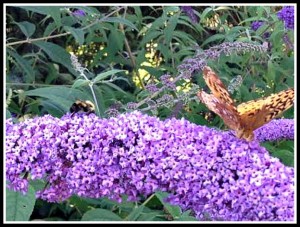Reason#1: Bring Life to Your Garden
It’s a heck of a lot more interesting to sit in a garden buzzing with life than it is to sit in a still one. You can watch the birds bathing, see butterflies and bees up close, and count the frogs.
The truth is, if your garden is missing its wildlife, you probably won’t be sitting in it very often, either.
Liz Primeau, a Canadian gardener and author, describes the difference between a lively garden and a lifeless one in her book, Front Yard Gardens. “Esthetics may have been the primary reason I finally dug up the lawn and planted a front yard garden,’ she writes, “but I did have other more lofty considerations. Over the years I’d come to consider our lawn more than merely boring, there seemed to be something wrong with it. The birds and the bees shunned it, the bugs stayed away in droves. There was no movement, no rustling, no chirping Jiminy crickets to leap up in front of me as I passed by on the pathway … ”
The garden that is busy and buzzing will call you out to be a part of it far more often than will the one that may be beautiful but supports no life. Your kids will like it better, too.
Reason #2: Do Less Work
If you read any horticultural magazine or watch a garden show, generally gardening seems like a lot of work. It involves a lot of digging, a lot of testing and amending soil, a lot of balancing compost ingredients just so, a lot of raking leaves in the fall, and more. If, however, you have a simple compost corral like mine (more about this in a future post), use lots of mulch, and essentially leave the soil alone to enrich itself with natural plant materials and leaves, you’ll have less backache-inducing work to do.
Which means, of course, that you’ll have more time to enjoy your livelier, healthier garden, perhaps sitting in your garden swing and enjoying the view.
I am not for one moment suggesting that you’ll do no work. All gardens require work. But you can do a different kind of work, some of which can save you money.
Reason #3: Spend Less Money
Use your extra time to propogate your plants in various ways. You can divide them, take leaf, stem, or root cuttings, dig up and store tubers such as cannas and break them into more pieces in the spring, and more.
In Serendipity Gardens, we have two large, rather ungainly forsythia shrubs in the front garden. You might be thinking, I don’t want more forsythias, but that is not the point. The point is, we accidentally multiplied our forsythia collection without cost. We let the shrubs grow too many years without pruning, and they got ridiculously large. Finally, my husband tackled the pruning job, crawling around under low-hanging branches and sawing off two truck-loads full of unnecessary ones. But he also found several stems that had begun to root where they touched the ground. He dug those up, getting as much root as possible, and planted seven new plants out near the road. Seven new plants for free! Those same plants would have cost well over $100 in the nursery. And even if they are a one-season wonder, their burst of bright yellow is pretty wonderful after a long, white winter.
In addition, once it gets going, your eco-friendly garden for the most part takes care of its own problems, which translates into no more pesticicde purchases. Instead, you can say thank you to the birds, the good bugs, and the frogs.
A Simple Step to Take
So, how do you go about making your garden more eco-friendly? It’s not an overnight process, but here is one simple thing to do.
Pick just one bed or area of your garden. Resolve never to dig it again. Instead, do these things:
- Lay a thick layer (four pages thick) of black and white newsprint or brown paper over the area you are using, overlapping the pieces well to keep weeds from coming through. (If you leave even the smallest crack of light, those weeds will find it!)
- Wet it down.
- Add a 4-inch layer of compost over the newspaper. (You can purchase compost if you don’t make your own.)
- Plant a variety of plants that attract birds, bees, or butterflies into the compost. The roots will grow right through the newsprint.
- Top with mulch of your choice.
- Water well.
And just like that, you are on your way to a healthier, happier garden experience.
If you want more detailed directions, or just want to read a good garden story, read the New York Times story, “Fending Off Weeds with Newsprint” by Anne Raver.
Like this post? Subscribe to my blog to learn more about Serendipity Gardens. (We will never loan, sell or rent your email address. That’s a promise!) And please, join the discussion and use the buttons below to share with others.

